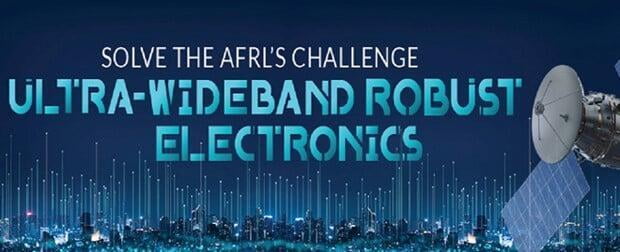
Wright Brothers Institute has extensive experience developing and executing Grand Challenges for the Air Force Research Laboratory. Grand Challenges are programs that seek to foster collaboration and new partnerships engaged to tackle a specific Department of Defense issue. They attract non-traditional partners that often work under a tight deadline, with high monetary rewards and potential government contracts as an added incentive. Challenges are typically one-off efforts, with the challenge award effectively ending the challenge itinerary.
For the latest Grand Challenge – the Ultra-Wideband & Robust Electronics (UREM) Challenge – WBI’s Innovation team devised a different approach. The UREM Challenge sought to identify partners with the capability to explore novel circuit and system architectures to develop leap-ahead technologies capable of UREM operating at RF frequency from MHz to Ku-Band and advanced mm-Wave technology. AFRL is also interested in adding an intelligent control to the hardware, which will allow future systems to deal with dynamically congested and contested spectrum.
For this Challenge, WBI created a more nuanced “stage gate” approach to finding the right concepts and partners for AFRL investment. In essence, Phase I, completed in early 2022, will be used as the basis for downselecting teams for Phase II.
In Phase I, a wide net was cast to attract as many idea submissions as possible. A relatively small prize - in this case, $10,000 – was awarded to teams chosen by the selection committee, just enough money for the winning teams to flesh out whether their plan really has dual use market-driven opportunity. The teams must identify the dual use market-driven opportunity and identify the key challenge in making it work, reporting back to the WBI as ‘managers’ of the Challenge.
That report is the basis for the second gate (up to a $75,000 award) to solve just that key challenge. If the teams make it this far, it’s clear that their idea has good market pull and it is feasible to build. From that point AFRL is free to invest further, develop a CRADA, or let the company take the concept to market by themselves with no extra encumbrance from the Air Force. This helps companies steer toward marketable products with no strings attached.
The idea is to use a small amount of Air Force funds to spur companies into building products that the Air Force can use.
The AFRL evaluation team chose eight winners, with the $10,000 award to be used as outlined above. The resulting reports will be the basis for the downselect for the second phase of the award of up to $75,000K to see if they can solve that challenge and build the product.
Phase I winners are:
- Autonomous STAR Front-End, University of Colorado Boulder
- Adaptable RF Front-End A.I. Controller, Collins Aerospace
- SOI CMOS for High Linearity Components, LintrinsIC Semiconductors Inc.
- Deep Learning 5G-Radar Spectrum Sharing, Tiami, LLC
- OTAVA WP1 Wideband Tunable LNA/Filter; Otava Inc./PellonTech LLC
- OTAVA WP4 Wideband Multi-VNA for RFICs, Otava Inc./PellonTech LLC
- Qorvo Ultra-Wideband Robust Electronics Challenge, Qorvo
- Engin-Ic_Ka Bank Dual Use High Efficiency GaN PA, Engin-IC.........
